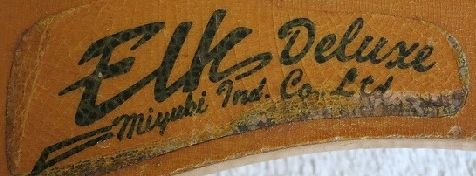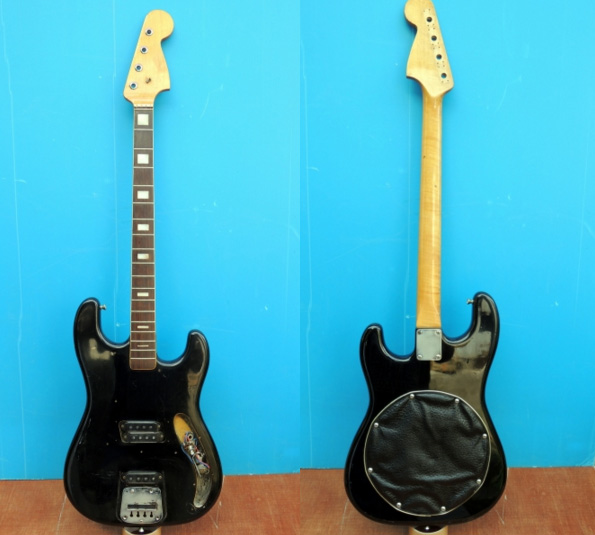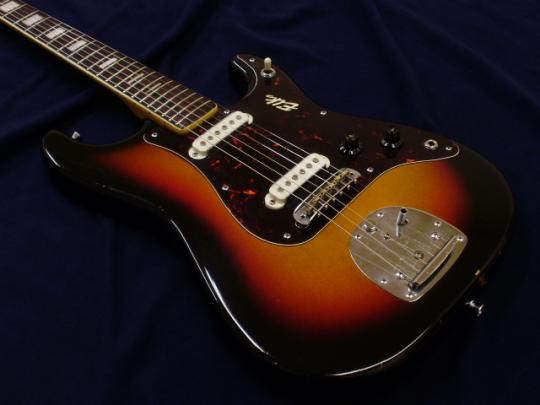Get ready for a kind of mind-blowing ride.
I actually may know more about Elk than I do about any of the other Japanese guitars as I've met Mr. Takahiro Saito twice as well as have read a few interviews with him concerning his days with Elk. Sadly, I've never brought out the camera for a photo when I've met him. He's 80 years old now, and in slightly delicate health these days.
Elk started out as a company called Miyuki Industrial Corporation, founded by Mr. Yukiyasu (?) Yamada (never heard his first name pronounced, so may be reading the kanji wrong). He had been tinkering with electronics since he was young, and was also an avid fan of Country and Western Music, and a remarkable steel guitar player who built his own amps for gigs. His amps sounded good, and he got requests from other guitar players to build amps for them, especially as his work was comparable to the best Fender amps at the time, but at half the price. By 1963 he had founded Miyuki Industrial and started selling his amps under the "Echo" brand name. They were a big hit, and were well regarded by professional musicians. When the first guitar boom hit Japan in 1965 with the advent of Beatles-mania and the Ventures, it was expedient for Miyuki Industrial to start producing guitars as well, and so Mr. Yamada turned to his friend Takahiro Saito (whom he knew through Country & Western Circles) and asked him to head up their guitar division of Miyuki Industrial. While mulling over a name for the guitar line, Saito, who had an affinity for hunting suggested "Elk" - as it was three letters, and easy to remember, and it sounded like a conjunction of "Eleki Gita" the Japanese phrase for "Electric Guitar" This became not only the name of the guitars, but of the amps as well.

circa 1968 Miyuki Industrial Elk Pro-Sonic - despite it's appearance, not actually based on a Fender Circuit. 2x10 combo powered by two EL-34s
Takahiro Saito was born in 1935 in Tokyo. He learned to sing English version of country songs before he even learned to speak English, and became famous for his near dead-on Johnny Cash covers and translations into Japanese (later, Cash and Saito would go on to become friends, and Saito appeared on Cash's show, and was also mentioned in Cash's original autobiography Man In Black). Saito was also famous for the guitar he built himself, and which he played throughout his career.

Signed single featuring Takahiro Saito with his homemade guitar - "T. Saito" is branded into the top, and though the headstock says "Elk" those are just Letraset letters as this guitar pre-dates his time with Elk. The story of this single is itself kind of mind-blowing. Mandom was such a huge hit in the aftershave market that they had a commercial featuring Charles Bronson, and a theme song written and performed by Jerry Wallace. This single is the Japanese version of the single as sung and performed by Saito.
Though Saito was a good craftsman, and he had built his own guitar, he did not know too much about manufacturing on a mass basis, and also didn't know so much about electric guitars - This is where the story gets really good. The first guitar Yamada and Saito decided to copy was a Fender Jaguar, which they went out and bought at great expense. They then began to take the whole thing apart and reverse engineer it. One of the key points they were interested in was the truss rod, which was different than the typical truss rods used in Japan at the time, so they took the guitar to Yamada's brother who was a dentist and X-rayed the neck to get a look at the truss rod, but even that wasn't good enough, so later Saito removed the whole fretboard and extracted the truss rod so they could examine it more thoroughly.
Once you've chopped up the neck. You might as well manually unwind those pickups and count every single turn, right? Sure. One of the keys to Elk Guitars great success among professional musicians were the outstanding pickups. They counted the winds, measured the gauss from the Alnico pickups, and then modified them slightly to suit their needs and had them made by a company called Wakakura Manufacturing, which would later be absorbed by the Sony Corporation. The Elk pickups are just as good, and some people even say better, than the Fender Jaguar pickups of the time.
When they looked at the pickguard, they weren't quite sure how to get the tortoiseshell look of the celluloid, until one of the workers suggested that it looked somewhat similar to a soap-dish, (Japanese soap-dishes at this time apparently featured a kind of swirling celluloid pattern - this may also be the story of the Mory and Sharp 5 pickguards as well), and so Saito walked around Tokyo visiting various soap dish manufacturers who all told him to get lost when he showed them the pickguard, until he finally found one who said "You can't reproduce something like this - a pattern like this is just a coincidence - but I'll give it a try" and thus they lined up their pickguard manufacturer. The name of the manufacturer was Dainippon Celluloid (still exists as a chemical corporation today, but no longer seems to be involved in nitrocellulose manufacture though they do still manufacture other cellulose products).
Last came the body - to get the bodies for their guitars made, and to learn more about the mass production of electric guitar bodies, Saito chose Chaki Guitars out of Kyoto to be his sub-contractor, and he apprenticed with him (why Saito chose Chaki - who was a manufacturer of mostly acoustic instruments - has never been explained to me - though I believe they were previously friends). He took the painted Jaguar body to Chaki, and asked Chaki what kind of wood was used to make it, and Chaki, who was a bit of a rascal apparently, picked up the body, tapped it a few times and said "It's Buna (Japanese Beech)" - it turns out the real reason he said this is that he had a large stock of Japanese Beech which he had been experimenting with for making acoustic guitars and found it unsuitable, but figured it would be ok for solid bodies under a few layers of paint. Japanese Beech has a tendency to make minute splits in the surface though, which after a few months, would crack the upper layers of paint as well. Thus the first couple hundred Elk Deluxe guitars were mostly returned with complaints. (Many years later Yamaha also experimented with Japanese Beech as a wood, but sealed it inside of a hard coat of lacquer to prevent it from splitting)
Chaki was apparently also quite a genius, but somewhat eccentric, and a heavy drinker. Saito said his apprenticeship with Chaki usually involved a great deal of drinking, and even then Chaki would get on the Pin Router and carve out Elk bodies just by looking at the Jaguar body hung on the wall, and then he would finish them with hand planes and sanders - which resulted in all the initial Elk bodies being slightly different from each other as well!
Finally, shortly before Elk got their guitars into full production, a corporation called Yamano - which had an exclusive license to import Fender Guitars and Amps - threatened to sue Elk because the copies were going to be too accurate! This resulted in the claw for the pickups becoming a straight bar, the tailpiece becoming a pentagon shape (though these had already been tooled up for production, so the screw holes actually line up exactly with Fender Jaguars according to Saito), and the infamous Shrimp-tail headstock.

Infamous Elk Deluxe Shrimp Tail headstock. This headstock shape was also used on the Elk Country. Note the early logo - these things are notorious for flaking off. The Shrimp Tail headstock eventually disappeared at the end of 1967 when either Elk decided they didn't care if they got sued, or reached some sort of an agreement with Yamano Corporation which represented Fender in Japan. From 1968 onwards, Elk Deluxe guitars have a Fender style headstock and round tailpiece.

Later version of the logo. It would go through several permutations depending on the year, or the guitar.

An Elk Deluxe which has had a DIY shrimp tail re-carving.
After the initial run of Elk Deluxes produced by Chaki, Miyuki tooled up one of their warehouses at their amp production plant in Eifukucho, Tokyo, and started producing Elk guitars themselves here. They switched to Mahogany bodies, which gives Elk Deluxe's their only caveat - they are much heavier than Fender guitars. This lasted only a few years though before the Eifukucho factory was burned down in a fire ("Probably from someone smoking" Saito told me "We all smoked back then") After that, the later Elks (from roughly end of 1968 onwards) were produced by the famous Matsumoku plant in Nagano, but were still assembled at another warehouse in Eifukucho. Elk made several different models in addition to the Deluxe, inlcuding the Country, the Wildcat (like a two pickup Stratocaster, with a Jazzmaster style tailpiece), the Galaxy, and the Cutlass (a wonderful copy of a Telecaster featuring a cut-out with a leather pad like a Gretsch Country Gentlemen to reduce weight)


c. 1968 Elk Cutlass - note change to Block Logo and Leather Pad
Around roughly 1968 or 1969, the Elk brand was purchased by Kanda Shokai, the company which also produced the Greco brand of guitar. Though never producing them in large numbers, for a few years at the beginning of the 70's you would see some very unusual Elk knock-offs of other guitars (including a lucite Dan Armstrong/Ampeg company, and even a one-off early Zemaitis Clone). Eventually Kanda Shokai pushed their Greco brand more than the Elk Guitar brand, and the Elk guitar brand died off. Miyuki Industrial's Amplifier division continued to make limited numbers of Amplifiers (and also an incredibly good early, early clone of the Big Muff's Ram's Head), PA equipment, and tape echo units, until Kanda Shokai received the contract for Fender Japan, at which point the Elk Amplifier Factory just started manufacturing Fender Amplifiers for Fender Japan.

Unique Elk Zemaitis clone.
Saito himself made the transition from Elk to Kanda Shokai, and then from there to Fender Japan. He continued to innovate and design many different guitar parts and improve upon previous designs - especially tuners, bridges, and tailpieces. He met Leo Fender on several occasions as well. He continues to reside in Tokyo and still occasionally travels to Nashville and perform at the Grand Old Opry.
Incredibly, sadly, and unfortunately, Mr. Yamada is no longer around. (edited out of consideration)

Saito seated front left, and Yamada top right (corrected), with a late 50's/early 60's country group they played together in known as "The Country Gentlemen".
That's all I have for now. I will try and get some more pictures of other Elks up, and some pictures of an early Elk Deluxe that I received from Saito which I am in the process of restoring.
For other people on here who have Elk Deluxes please share them here. I know there are a few out there. If you can find an old Elk Deluxe, they're great, great guitars. A little heavy, but seriously well built.
Anyway, just wanted to shed some light on some other Japanese Guitar History. Please excuse any typos, etc. Late night ramble post.
(Edited with new information 4/19/2016)













